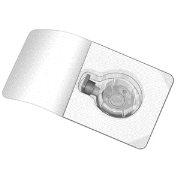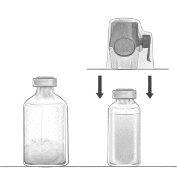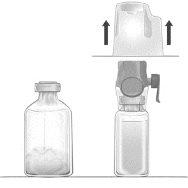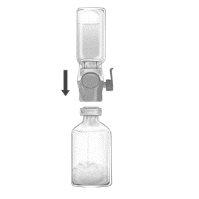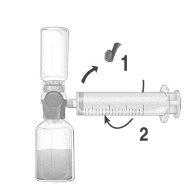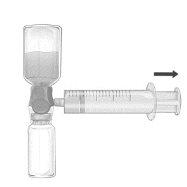
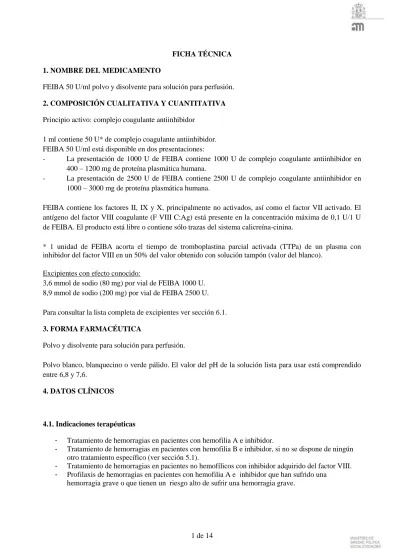
ФЕЙБА 100 МЕ/мл ПОРОШОК И РАСТВОРИТЕЛЬ ДЛЯ ПРИГОТОВЛЕНИЯ РАСТВОРА ДЛЯ ИНФУЗИЙ

Спросите врача о рецепте на ФЕЙБА 100 МЕ/мл ПОРОШОК И РАСТВОРИТЕЛЬ ДЛЯ ПРИГОТОВЛЕНИЯ РАСТВОРА ДЛЯ ИНФУЗИЙ

Инструкция по применению ФЕЙБА 100 МЕ/мл ПОРОШОК И РАСТВОРИТЕЛЬ ДЛЯ ПРИГОТОВЛЕНИЯ РАСТВОРА ДЛЯ ИНФУЗИЙ
Введение
Прошпект: информация для пользователя
FEIBA 100U/ml порошок и растворитель для раствора для инфузии
антиингибиторный коагулянтный комплекс
Прочитайте внимательно весь прошпект перед началом использования этого лекарства, поскольку он содержит важную информацию для вас.
- Сохраните этот прошпект, поскольку вам может потребоваться перечитать его.
- Если у вас есть какие-либо сомнения, проконсультируйтесь с вашим врачом или фармацевтом.
- Это лекарство было назначено только вам, и не передавайте его другим людям, даже если у них есть те же симптомы, что и у вас, поскольку оно может нанести им вред.
- Если вы испытываете побочные эффекты, проконсультируйтесь с вашим врачом или фармацевтом, даже если это побочные эффекты, которые не указаны в этом прошпекте. См. раздел 4.
Содержание прошпекта
- Что такое FEIBA и для чего он используется
- Что нужно знать перед началом использования FEIBA
- Как использовать FEIBA
- Возможные побочные эффекты
- Хранение FEIBA
- Содержание упаковки и дополнительная информация
1. Что такое FEIBA и для чего он используется
FEIBA - это препарат, изготовленный из человеческой плазмы, который позволяет обеспечить гемостаз, даже когда количество конкретных факторов свертывания крови снижено или отсутствует.
FEIBA используется для лечения и профилактики кровотечений у пациентов с гемофилией А с ингибитором.
FEIBA используется для лечения кровотечений у пациентов с гемофилией Б с ингибитором.
FEIBA может быть использован для лечения и профилактики кровотечений у не-гемофилических пациентов с приобретенным ингибитором фактора VIII.
Кроме того, FEIBA используется для профилактики во время хирургических вмешательств у пациентов с гемофилией А с ингибитором.
FEIBA может быть использован у пациентов всех возрастных групп.
2. Что нужно знать перед началом использования FEIBA
Сообщите вашему врачу, если у вас есть известная аллергия.
Сообщите вашему врачу, если вы придерживаетесь диеты с низким содержанием натрия.
Не используйте FEIBA
FEIBA следует использовать только в следующих обстоятельствах, если, например, из-за очень высокого титра ингибиторов не ожидается никакой реакции на лечение концентратом фактора свертывания:
- если вы аллергичны (гиперчувствительны) к антиингибиторному коагулянтному комплексу или к любому другому компоненту этого лекарства (перечисленному в разделе 6).
- если существует дискреминированная внутренняя коагуляция (ДВК). (ДВК = коагулопатия потребления, потенциально смертельное состояние, при котором происходит чрезмерная коагуляция крови, с выраженным образованием тромбов в кровеносных сосудах. Это приводит к потреблению факторов свертывания во всем организме).
- в случае инфаркта миокарда, тромбоза и/или эмболии: FEIBA должен быть использован только в случаях кровотечения, которые представляют угрозу для жизни.
Предостережения и меры предосторожности
Проконсультируйтесь с вашим врачом перед началом использования FEIBA, поскольку могут возникнуть реакции гиперчувствительности, как и в случае всех продуктов, полученных из плазмы, которые вводятся внутривенно. Чтобы как можно раньше распознать аллергическую реакцию, необходимо знать, что первые потенциальные симптомы реакции гиперчувствительности могут быть:
- эритема (покраснение кожи)
- сыпь на коже
- появление волдырей на коже (уртикария)
- зуд по всему телу
- отек губ и языка
- затруднение дыхания/диспноэ
- давление на грудь
- общее недомогание
- головокружение
- падение артериального давления
Другими симптомами реакций гиперчувствительности на продукты, полученные из плазмы, являются летаргия и усталость.
Если вы заметите любой из этих симптомов, необходимо немедленно прекратить введение и связаться с вашим врачом. Эти симптомы могут указывать на анафилактический шок. Тяжелые симптомы требуют срочного лечения.
Ваш врач будет использовать FEIBA снова у пациентов с подозрением на гиперчувствительность к продукту или любому из его компонентов только после тщательной оценки ожидаемой пользы и риска повторного введения и/или отсутствия реакции на другое профилактическое или альтернативное лечение.
- Если вы испытываете значительные изменения артериального давления или частоты пульса, затруднения дыхания, кашель или боль в груди, необходимо немедленно прекратить введение и связаться с вашим врачом. Ваш врач начнет соответствующие диагностические и терапевтические меры.
- У пациентов с гемофилией с ингибиторами или с приобретенными ингибиторами факторов свертывания. Во время лечения FEIBA эти пациенты могут иметь повышенную склонность к развитию кровотечения и повышенный риск тромбоза одновременно.
Во время лечения FEIBA произошли тромботические и тромбоэмболические события, включая дискреминированную внутренняя коагуляция (ДВК), венозный тромбоз, легочную эмболию, инфаркт миокарда и инсульт. Вероятно, что одновременное использование с рекомбинантным фактором VIIа увеличивает риск развития тромбоэмболического события. Некоторые из тромбоэмболических событий произошли при лечении высокими дозами FEIBA.
В одном исследовании, проведенном другой компанией для оценки эмичумаба (лекарства для предотвращения кровотечений у пациентов с гемофилией А), некоторые пациенты, которые испытывали межтекущие кровотечения, были лечены FEIBA для контроля кровотечений, и некоторые из этих пациентов развили микроангиопатическую тромботическую (МАТ) болезнь. МАТ - это тяжелое и потенциально опасное для жизни состояние. Когда это состояние возникает, может быть повреждена стенка сосуда, и могут образовываться тромбы в небольших кровеносных сосудах. В некоторых случаях это может привести к повреждению почек и других органов. В случае межтекущих кровотечений во время профилактики эмичумабом необходимо немедленно связаться с вашим гематологом или Центром лечения гемофилии.
Когда вводятся лекарства, полученные из плазмы или человеческой крови, необходимо принять определенные меры для предотвращения передачи инфекций пациентам. Такие меры включают тщательный отбор доноров, чтобы исключить тех, кто находится в группе риска быть носителями инфекционных заболеваний, анализ маркеров конкретных инфекций в индивидуальных донорских материалах и в плазменных пулах, а также включение этапов в процессе производства для удаления/инактивации вирусов. Несмотря на это, когда вводятся лекарства, полученные из человеческой крови или плазмы, возможность передачи инфекционных агентов не может быть полностью исключена. Это также относится к возникающим вирусам или вирусам неизвестной природы или другим типам инфекций.
Эти меры считаются эффективными для вирусов с оболочкой, таких как вирус иммунодефицита человека (ВИЧ), вирус гепатита Б и вирус гепатита С, и для не-вirusных вирусов гепатита А. Меры, принятые, могут иметь ограниченную ценность для не-вirusных вирусов, таких как парвовирус В19. Инфекция парвовирусом В19 может быть тяжелой для беременной женщины (инфекция плода) и для людей с ослабленной иммунной системой или для пациентов с некоторыми формами анемии (например, болезнь дрепанокитом или гемолитическая анемия).
Возможно, что ваш врач порекомендует вам вакцинацию против гепатита А и гепатита Б, если вам регулярно или повторно вводятся продукты, полученные из плазмы, для ингибиторов фактора VIII.
После введения высоких доз FEIBA может произойти временное увеличение передаваемых пассивно антител к поверхности гепатита Б, что может привести к неправильной интерпретации результатов серологического теста.
FEIBA - это производное плазмы и может содержать вещества, которые реагируют при введении пациентам, вызывая присутствие изогемагглютининов (антител, которые вызывают слипание красных кровяных клеток другого человека). Этот процесс может привести к неправильной интерпретации результатов анализов крови.
Рекомендуется вести учет каждого введения дозы FEIBA, включая название лекарства и номер партии, для поддержания учета использованных партий.
Дети
Опыт использования у детей младше 6 лет ограничен; необходимо адаптировать ту же дозировку, что и для взрослых, к клиническому состоянию ребенка.
Другие лекарства и FEIBA
Сообщите вашему врачу или фармацевту, если вы используете, недавно использовали или можете использовать любое другое лекарство.
Не проводились адекватные и хорошо контролируемые исследования сочетанного или последовательного использования FEIBA и рекомбинантного фактора VIIа, антифибринолитиков или эмичумаба. Когда используются системные антифибринолитические препараты, такие как транексамовая кислота и аминокапроновая кислота, во время лечения FEIBA необходимо учитывать возможность возникновения тромбоэмболических событий. Поэтому не следует использовать антифибринолитические препараты до примерно 6-12 часов после введения FEIBA.
Согласно имеющимся данным in vitro и клиническим наблюдениям, нельзя исключить потенциальное лекарственное взаимодействие при одновременном использовании с рекомбинантным фактором VIIа, которое потенциально может привести к тромбоэмболическому событию. Сообщите вашему врачу, если вы будете лечены FEIBA после получения эмичумаба (лекарства для предотвращения кровотечений у пациентов с гемофилией А), поскольку необходимо учитывать некоторые специфические предостережения и меры предосторожности. Ваш врач будет проводить тщательный контроль.
Как и все продукты, используемые для свертывания крови, FEIBA не должен смешиваться с другими лекарствами перед введением, поскольку это может повлиять на эффективность и переносимость продукта. Рекомендуется промыть вену изотоническим солевым раствором до и после введения FEIBA.
Беременность, лактация и фертильность
Если вы беременны или кормите грудью, считаете, что можете быть беременной или планируете стать беременной, проконсультируйтесь с вашим врачом или фармацевтом перед использованием этого лекарства.
Ваш врач решит, может ли FEIBA быть использован во время беременности и лактации. Из-за повышенного риска тромбоза во время беременности FEIBA должен быть введен только под тщательным медицинским контролем и только если он明но показан. Для информации о риске инфекции парвовирусом В19 см. раздел предостережения и меры предосторожности.
Вождение и использование машин
Нет признаков того, что FEIBA может повлиять на способность управлять транспортными средствами и работать с машинами.
FEIBA содержит натрий
500 У
Это лекарство содержит примерно 40 мг натрия (основной компонент столовой соли/кухонной соли) в каждом флаконе. Это эквивалентно 2% от максимальной рекомендуемой суточной нормы потребления натрия для взрослого.
1000 У
Это лекарство содержит примерно 80 мг натрия (основной компонент столовой соли/кухонной соли) в каждом флаконе. Это эквивалентно 4% от максимальной рекомендуемой суточной нормы потребления натрия для взрослого.
2500 У
Это лекарство содержит примерно 200 мг натрия (основной компонент столовой соли/кухонной соли) в каждом флаконе. Это эквивалентно 10% от максимальной рекомендуемой суточной нормы потребления натрия для взрослого.
3. Как использовать FEIBA
Растворите лиофилизированный порошок FEIBA в растворителе, включенном в комплект, и введите раствор внутривенно.
Следуйте точно инструкциям по введению этого лекарства, указанным вашим врачом. В случае сомнений проконсультируйтесь с вашим врачом или фармацевтом.
Ваш врач определит частоту и дозу, необходимые для вас лично, исходя из тяжести нарушения свертывания крови, местоположения и величины кровотечения, а также клинического состояния и реакции на препарат. Не изменяйте дозировку, установленную вашим врачом, и не прекращайте введение препарата.
Если вы считаете, что эффект FEIBA слишком сильный или слишком слабый, проконсультируйтесь с вашим врачом или фармацевтом.
Нагрейте продукт до комнатной температуры или температуры тела перед введением, если необходимо.
FEIBA должен быть растворен непосредственно перед введением. Раствор должен быть использован немедленно (поскольку препарат не содержит консервантов).
Аккуратно встряхните до полного растворения продукта. Убедитесь, что FEIBA полностью растворен, поскольку в противном случае активный материал может быть задержан в фильтре оборудования.
Растворы, имеющие мутный вид или содержащие осадки, должны быть утилизированы.
Не повторно используйте открытые упаковки.
Используйте только воду для инъекций и оборудование для растворения, включенные в упаковку.
Если используются другие оборудования, отличные от включенных, убедитесь, что используете фильтр с размером пор не менее 149 мкм.
Не используйте продукт, если система барьерной стерильности или упаковка повреждены или показывают любой признак ухудшения.
Не охлаждайте после растворения.
После полного растворения FEIBA введение или инфузия должно начаться немедленно и должно быть завершено в течение 3 часов после растворения.
Утилизация неиспользованного лекарства и всех материалов, которые были в контакте с ним, должна быть проведена в соответствии с местными правилами.
Растворение порошка для приготовления раствора для инфузии с помощью оборудования BAXJECT II Hi-Flow:
- Нагрейте нераскрытый флакон растворителя (воду для инъекций) до комнатной температуры или максимально 37°C, если необходимо, например, используя водяную баню в течение нескольких минут.
- Удалите защитные колпачки с флакона порошка и флакона растворителя и продезинфицируйте резиновые колпачки обоих флаконов. Положите флаконы на ровную поверхность.
- Откройте упаковку оборудования BAXJECT II Hi-Flow, удалив защитную пленку, не трогая содержимое упаковки (Рисунок а). Не удаляйте оборудование из упаковки.
- Переверните упаковку и вставьте прозрачный пластиковый наконечник через резиновый колпачок флакона растворителя (Рисунок б). Теперь удалите оборудование BAXJECT II Hi-Flow из упаковки (Рисунок в). Не удаляйте защитный синий колпачок с оборудования BAXJECT II Hi-Flow.
- С оборудованием BAXJECT II Hi-Flow, подключенным к флакону растворителя, переверните систему так, чтобы флакон растворителя был в верхней части оборудования. Вставьте фиолетовый пластиковый наконечник оборудования BAXJECT II Hi-Flow через колпачок флакона FEIBA. Вакуум заставит растворитель проникнуть в флакон FEIBA (Рисунок г).
- Аккуратно встряхните всю систему до полного растворения порошка. Убедитесь, что FEIBA полностью растворен, поскольку в противном случае активный материал может быть задержан в фильтре оборудования.
Рисунок а | Рисунок б | Рисунок в |
|
|
|
Инфузия
Используйте асептическую технику во время всего процедуры!
- Удалите защитный синий колпачок с оборудования BAXJECT II Hi-Flow. Подключите шприц к оборудованию BAXJECT II Hi-Flow. НЕ ВВОДИТЕ ВОЗДУХ В ШПРИЦ. (Рисунок е). Рекомендуется использовать шприц Luer Lock, чтобы обеспечить надежное соединение между шприцем и оборудованием BAXJECT II Hi-Flow (поверните шприц по часовой стрелке до упора).
- Переверните систему так, чтобы растворенный продукт был в верхней части. Введите растворенный продукт в шприц, медленно вытягивая поршень и обеспечивая надежное соединение между устройством BAXJECT II Hi-Flow и шприцем во время всего процесса вытягивания поршня шприца (Рисунок ж).
- Отключите шприц.
- Если в шприце образуется пена, подождите, пока пена не уменьшится. Медленно введите раствор внутривенно с помощью оборудования для инфузии.
Рисунок г | Рисунок д | Рисунок е |
|
|
|
Не превышайте скорость инфузии 10 У FEIBA/кг в минуту.
Если вы используете больше FEIBA, чем необходимо
Сообщите вашему врачу немедленно. Передозировка FEIBA может увеличить риск побочных эффектов, таких как тромбоэмболия (образование тромба в кровеносных сосудах), дискреминированная внутренняя коагуляция (ДВК) или инфаркт миокарда. Некоторые тромбоэмболические события были зарегистрированы при дозах выше 200 У/кг/день или у пациентов с другими факторами риска тромбоэмболических событий. Если наблюдаются признаки или симптомы тромбоэмболического события, инфузия должна быть немедленно прекращена, и должны быть приняты необходимые диагностические и терапевтические меры.
В случае передозировки или случайного приема внутрь проконсультируйтесь с вашим врачом или фармацевтом или позвоните в Службу токсикологической информации, телефон 91 562 04 20, указав лекарство и количество, принятое внутрь.
4. Возможные побочные эффекты
Как и все лекарства, это лекарство может вызывать побочные эффекты, хотя не все люди их испытывают.
Частые побочные эффекты(могут повлиять до 1 из 10 пациентов)
Гиперчувствительность, головная боль, головокружение, гипотония, кожная сыпь, положительные поверхностные антигены гепатита Б.
Побочные эффекты с неизвестной частотой(не могут быть оценены на основе доступных данных)
Расстройства крови и лимфатической системы:диффузная внутрисосудистая коагуляция (ДВС), увеличение титра ингибитора.
Расстройства иммунной системы:анафилактические реакции, кожная сыпь по всему телу (уртикария).
Расстройства нервной системы:онемение конечностей (гипоэстезия), аномальная или уменьшенная чувствительность (парестезия), инсульт (тромботический или эмболический), сонливость, нарушение вкуса (дисгевзия).
Расстройства сердца:сердечный приступ (инфаркт миокарда), сердцебиение (тахикардия).
Расстройства сосудов:образование тромбов с покраснением сосудов (тромбоэмболические события, венозный и артериальный тромбоз), повышение артериального давления (гипертония), краснота.
Расстройства дыхательной, грудной и медиастинной системы:обструкция легочной артерии (легочный эмбол), обструкция дыхательных путей (бронхоспазм), свист в груди, кашель, затруднение дыхания (диспноэ).
Расстройства желудочно-кишечной системы:рвота, диарея, абдоминальный дискомфорт, чувство болезни (тошнота).
Расстройства кожи и подкожной ткани:онемение лица, отек лица, языка и губ (ангиоэдем), кожная сыпь по всему телу (уртикария), зуд (прурит).
Общие расстройства и изменения в месте введения:боль в месте инъекции, общий дискомфорт, чувство жара, озноб, лихорадка, боль в груди, дискомфорт в груди.
Дополнительные исследования:падение артериального давления, увеличение уровня Д-димера фибриногена в крови.
Быстрая внутривенная перфузия может вызвать острую боль и онемение лица и конечностей, а также снижение артериального давления.
Были зарегистрированы случаи инфаркта миокарда после введения доз, превышающих максимальную суточную дозу, и/или при длительном введении и/или при наличии факторов риска тромбоэмболических осложнений.
Сообщение о побочных эффектах
Если вы испытываете любой побочный эффект, проконсультируйтесь с вашим врачом, даже если это возможные побочные эффекты, которые не указаны в этом листке-вкладыше. Вы также можете сообщить о них напрямую через Испанскую систему мониторинга безопасности лекарственных средств для человека: www.notificaram.es.
Сообщая о побочных эффектах, вы можете способствовать предоставлению более полной информации о безопасности этого лекарства.
5. Хранение ФЕИБА
Храните это лекарство в недоступном для детей месте.
Не храните при температуре выше 25°C. Не замораживайте.
Храните в оригинальной упаковке для защиты от света.
Не используйте это лекарство после истечения срока годности, указанного на этикетке и упаковке. Срок годности - последний день месяца, указанного на упаковке.
Лекарства не должны выбрасываться в канализацию или мусор. Спросите у вашего фармацевта, как утилизировать упаковку и лекарства, которые вам больше не нужны. Таким образом, вы поможете защитить окружающую среду.
6. Содержание упаковки и дополнительная информация
Состав ФЕИБА
Порошок
- Активное вещество в одном флаконе представляет собой антиингибиторный коагулянтный комплекс.
- 1 мл содержит 100 ЕД антиингибиторного коагулянта.
- ФЕИБА 100 ЕД/мл выпускается в трех формах:
- Форма выпуска 500 ЕД ФЕИБА содержит 500 ЕД (единицы) антиингибиторного коагулянта в 200 – 600 мг человеческого плазменного белка.
- Форма выпуска 1000 ЕД ФЕИБА содержит 1000 ЕД (единицы) антиингибиторного коагулянта в 400 – 1200 мг человеческого плазменного белка.
- Форма выпуска 2500 ЕД ФЕИБА содержит 2500 ЕД (единицы) антиингибиторного коагулянта в 1000 – 3000 мг человеческого плазменного белка.
ФЕИБА также содержит факторы II, IX и X, в основном неактивированные, а также активированный фактор VII. Антиген коагуляционного фактора VIII (FVIII C:Ag), а также факторы системы калликреин-кинин присутствуют только в следовых количествах.
- Остальные компоненты - хлорид натрия и цитрат натрия.
Растворитель
- Вода для инъекционных препаратов.
Внешний вид продукта и содержание упаковки
Продукт выпускается в виде лиофилизированного или рассыпного порошка белого или слегка зеленоватого цвета. Реконституированный раствор имеет pH между 6,5 и 7,3.
Порошок и растворитель поставляются в стеклянных флаконах, закрытых резиновыми пробками.
Презентация:1 х 500 ЕД
1 х 1000 ЕД
1 х 2500 ЕД
Возможно, что только некоторые размеры упаковок будут продаваться.
Содержание упаковки:
- 1 флакон с 500 ЕД/1000 ЕД/2500 ЕД ФЕИБА - порошок для раствора для инфузии
- 1 флакон с 5 мл/10 мл/25 мл воды для инъекционных препаратов
- 1 набор для реконституции BAXJECT II Hi-Flow
- 1 одноразовая шприц
- 1 бабочка-игла
Владелец разрешения на маркетинг и производитель
Владелец разрешения на маркетинг:
Baxalta Innovations GmbH
Industriestrasse, 67
1221 Вена, Австрия
Производитель:
Takeda Manufacturing Austria AG
Industriestrasse, 67
1221 Вена, Австрия
Местный представитель владельца
Takeda Farmacéutica España, S.A.
Калле Альбасете, 5, 9-й этаж,
Эдифисио Лос Кубос
28027 Мадрид
Испания
Тел: +34 91 790 42 22
Этот препарат разрешен в государствах-членах Европейского экономического пространства под следующими названиями:
Австрия:
FEIBA 100 ЕД/мл Порошок и растворитель для приготовления раствора для инфузии
Болгария:
FEIBA 100 ЕД/мл Порошок и растворитель для раствора для инфузии
Хорватия:
FEIBA 100 ЕД/мл Порошок и растворитель для раствора для инфузии
Кипр:
FEIBA 100 ЕД/мл Πорошок και διαλυτικό για διάλυμα για έγχυση
Чехия:
FEIBA
Дания:
Feiba
Эстония:
FEIBA 100 ЕД/мл
Финляндия:
Feiba
Германия:
FEIBA 500 Е концентрированный
FEIBA 1000 Е концентрированный
FEIBA 2500 Е концентрированный
Греция:
FEIBA 100 ЕД/мл Πорошок και διαλυτικό για διάλυμα για έγχυση
Ирландия:
FEIBA 100 ЕД/мл Порошок и растворитель для раствора для инфузии
Латвия:
Feiba 100 ЕД/мл Порошок и растворитель для раствора для инфузии
Литва:
Feiba 100 ЕД/мл Порошок и растворитель для раствора для инфузии
Мальта:
FEIBA 100 ЕД/мл Порошок и растворитель для раствора для инфузии
Нидерланды:
FEIBA 100 ЕД/мл Порошок и растворитель для раствора для инъекции
Норвегия:
Feiba
Румыния:
FEIBA 100 ЕД/мл Порошок и растворитель для раствора для инъекции
Словакия:
FEIBA 100 ЕД/мл Порошок и растворитель для раствора для инфузии
Словения:
FEIBA 100 ЕД/мл Порошок и растворитель для раствора для инфузии
Испания:
FEIBA 100 ЕД/мл Порошок и растворитель для раствора для инфузии
Швеция:
Feiba 100 ЕД/мл Порошок и растворитель для раствора для инфузии
Дата последнего пересмотра этой инструкции:08/2024
Подробная информация о этом препарате доступна на сайте Агентства по лекарственным средствам и медицинским изделиям Испании (AEMPS) http://www.aemps.gob.es/
---------------------------------------------------------------------------------------------------------------------
Эта информация предназначена только для медицинских специалистов:
Лечение должно быть начато и контролироваться под наблюдением врача с опытом лечения коагулопатий.
Дозировка
Доза и продолжительность терапии зависят от тяжести нарушения гемостаза, местоположения и тяжести кровотечения, а также от клинического состояния пациента.
Доза и частота введения должны устанавливаться в каждом случае в зависимости от клинической эффективности.
Как общее руководство, рекомендуется доза 50 – 100 ЕД/кг ФЕИБА; не следует превышать единовременную дозу 100 ЕД/кг или максимальную суточную дозу 200 ЕД/кг, если только тяжесть кровотечения не требует и не оправдывает использование более высоких доз.
Из-за специфических факторов пациентов реакция на обходной агент может варьироваться, и в ситуации с определенным кровотечением пациенты с недостаточной реакцией на один агент могут реагировать на другой агент. В случае недостаточной реакции на обходной агент следует рассмотреть возможность использования другого агента.
Педиатрическое население
Опыт использования у детей младше 6 лет ограничен; следует использовать тот же режим дозирования, что и для взрослых, с учетом клинического состояния ребенка.
- Спонтанное кровотечение
Кровотечения в суставах, мышцах и мягких тканях
Для легких и умеренных кровотечений рекомендуется доза 50 – 75 ЕД/кг каждые 12 часов. Лечение должно продолжаться до тех пор, пока не появятся явные признаки клинического улучшения, такие как уменьшение боли, снижение отека или увеличение подвижности сустава.
Для тяжелых кровотечений в мышцах и мягких тканях, например, ретроперитонеального кровотечения, рекомендуется доза 100 ЕД/кг каждые 12 часов.
Кровотечения в слизистых оболочках
Рекомендуется доза 50 ЕД/кг каждые 6 часов под строгим наблюдением за пациентом (визуальный контроль кровотечения, повторный гематокрит). Если кровотечение не останавливается, можно увеличить дозу до 100 ЕД/кг; однако не следует превышать дозу 200 ЕД/кг.
Другие тяжелые кровотечения
При тяжелом кровотечении, таком как кровотечение в центральной нервной системе, рекомендуется доза 100 ЕД/кг каждые 12 часов. В отдельных случаях можно вводить ФЕИБА каждые 6 часов, пока не появятся явные признаки клинического улучшения (не следует превышать максимальную суточную дозу 200 ЕД/кг).
- Хирургия
Во время хирургических вмешательств можно вводить начальную дозу 100 ЕД/кг до операции, и через 6 – 12 часов после операции можно вводить еще одну дозу 50 – 100 ЕД/кг. Как поддерживающая доза после операции можно вводить 50 – 100 ЕД/кг каждые 6 – 12 часов; доза, интервалы дозирования и продолжительность лечения пери- и постоперационного периода зависят от хирургического вмешательства, общего состояния пациента и клинической эффективности в каждом случае (не следует превышать максимальную суточную дозу 200 ЕД/кг).
- Профилактика у пациентов с гемофилией А с ингибитором
- Профилактика кровотечений у пациентов с высоким титром ингибитора и частыми кровотечениями, после неудачной попытки индукции иммунотолерантности (ИТ) или когда такая индукция не считается возможной:
Рекомендуется доза 70 – 100 ЕД/кг в чередующиеся дни. Если необходимо, дозу можно увеличить до 100 ЕД/кг в день или постепенно уменьшить.
- Профилактика кровотечений у пациентов с высоким титром ингибитора во время индукции иммунотолерантности (ИТ):
Можно вводить ФЕИБА в сочетании с фактором VIII, с интервалом дозирования 50 – 100 ЕД/кг, дважды в день, пока титр ингибитора фактора VIII не снизится до <2 ЕД.*< p>
* 1 Единица Бетесды определяется как количество антител, которое ингибирует 50% активности фактора VIII в плазме, инкубированной (2 часа при 37°C).
- Использование ФЕИБА у особых групп пациентов
ФЕИБА также использовался в сочетании с концентратом фактора VIII как длительное лечение для полного и постоянного удаления ингибитора фактора VIII.
Мониторинг
В случае неадекватной реакции на лечение продуктом рекомендуется провести подсчет тромбоцитов, поскольку считается необходимым наличие достаточного количества функционально целых тромбоцитов для эффективности лечения продуктом.
Из-за сложного механизма действия не существует прямого мониторинга активных начал. Тесты на коагуляцию, такие как время коагуляции крови (ВК), тромбоэластограмма (ТЭГ, значение r) и время тромбопластиной активации (ТПА), обычно показывают только незначительные сокращения, которые не обязательно коррелируют с клиническим улучшением. По этим причинам полезность этих тестов для мониторинга лечения ФЕИБА очень ограничена.
Форма введения
ФЕИБА должен вводиться медленно внутривенно. ФЕИБА следует вводить со скоростью 2 ЕД/кг/мин. У пациентов, которые хорошо перенесли скорость введения 2 ЕД/кг/мин, скорость введения можно увеличить до максимальной 10 ЕД/кг/мин.
ФЕИБА должен быть реконституирован непосредственно перед введением. Раствор должен быть использован немедленно (поскольку приготовление не содержит консервантов). Не использовать растворы с мутным видом или содержащие осадки. Утилизация неиспользованного препарата и всех материалов, которые были в контакте с ним, должна осуществляться в соответствии с местными правилами.
Мониторинг терапии
Не следует превышать единовременные дозы 100 ЕД/кг или суточные дозы 200 ЕД/кг. Пациенты, получающие более 100 ЕД/кг, должны быть под наблюдением за развитием синдрома потребления коагуляционных факторов (СПК) и/или острой коронарной недостаточности, а также за симптомами тромботических или тромбоэмболических осложнений. Для остановки кровотечения высокие дозы ФЕИБА должны вводиться только в течение строго необходимого времени.
Если возникают клинически значимые изменения артериального давления или частоты пульса, затруднение дыхания, кашель или боль в груди, введение должно быть немедленно прекращено, и должны быть приняты необходимые диагностические и терапевтические меры. Аналитические параметры, характерные для СПК, являются снижение фибриногена, снижение количества тромбоцитов и/или наличие продуктов разрушения фибриногена или фибрина (ПРФ). Другие параметры для развития СПК являются значительное удлинение времени тромбина, времени протромбина или времени тромбопластиной активации ТПА. У пациентов с гемофилией с ингибитором или с приобретенными ингибиторами факторов VIII, IX и/или XI ТПА удлинено из-за основного заболевания.
Введение ФЕИБА у пациентов с ингибитором может привести к первоначальному "анамнестическому" увеличению уровня ингибитора. Во время продолжительного введения ФЕИБА уровень ингибитора может снизиться со временем. И клинические данные, и опубликованные данные свидетельствуют о том, что эффективность ФЕИБА не снижается.
Пациенты с гемофилией с ингибитором или с приобретенными ингибиторами коагуляционных факторов, получающие лечение ФЕИБА, могут быть более склонны к кровотечению, а также могут иметь повышенный риск тромбоза.
Лабораторные тесты и клиническая эффективность
Витро-тесты для контроля эффективности, такие как ТПА, время коагуляции крови (ВК) и тромбоэластограмма (ТЭГ), не обязательно коррелируют с клиническим улучшением. По этой причине не следует стремиться к нормализации этих значений путем увеличения дозы ФЕИБА, и даже это сильно не рекомендуется из-за возможного риска развития СПК при передозировке.
Важность подсчета тромбоцитов
В случае неадекватной реакции на лечение ФЕИБА рекомендуется провести подсчет тромбоцитов, поскольку считается необходимым наличие достаточного количества функционально целых тромбоцитов для эффективности лечения ФЕИБА.
Лечение пациентов с гемофилией Б с ингибитором
Опыт использования у пациентов с гемофилией Б с ингибитором фактора IX ограничен из-за редкости заболевания. Пять пациентов с гемофилией Б с ингибитором были лечены ФЕИБА во время клинических испытаний, либо по требованию, либо в профилактических целях, либо во время хирургических вмешательств:
В одном перспективном, открытом, рандомизированном и параллельном клиническом исследовании у пациентов с гемофилией А или Б с постоянно повышенным титром ингибитора (090701, PROOF) 36 пациентов были рандомизированы для получения профилактического или по требованию лечения в течение 12 месяцев ± 14 дней. 17 пациентов в группе профилактического лечения получали 85 ± 15 ЕД/кг ФЕИБА, вводимого в чередующиеся дни, и 19 пациентов в группе лечения по требованию получали индивидуальное лечение, определяемое врачом. Два пациента с гемофилией Б с ингибитором получали лечение по требованию, и один пациент с гемофилией Б получал профилактическое лечение. Средняя годовая частота кровотечений (ГЧК) для всех типов эпизодов кровотечения у пациентов группы профилактического лечения (средняя ГЧК = 7,9) была ниже, чем у пациентов группы лечения по требованию (средняя ГЧК = 28,7), что представляет собой снижение ГЧК на 72,5% между группами лечения.
В другом завершенном, перспективном исследовании по наблюдению за безопасностью или неинтервенционном использовании ФЕИБА периоперационно (PASS-INT-003, SURF) было проведено в общей сложности 34 хирургических вмешательства у 23 пациентов. Большинство пациентов (18) страдали конгениальной гемофилией А с ингибитором, двое были пациентами с гемофилией Б с ингибитором, и трое были пациентами с приобретенной гемофилией А с ингибитором. Время экспозиции ФЕИБА варьировалось от 1 до 28 дней, со средним значением 9 дней и медианой 8 дней. Средняя накопленная доза составила 88347 ЕД, а медиана дозы - 59000 ЕД. У пациентов с гемофилией Б с ингибитором максимальная продолжительность экспозиции ФЕИБА составила 21 день, а максимальная введенная доза - 7324 ЕД.
Также в литературе описано 48 пациентов, у которых ФЕИБА использовался для лечения и профилактики эпизодов кровотечения у пациентов с гемофилией Б с ингибитором фактора IX (34 пациента с гемофилией Б с ингибитором получали лечение по требованию, 6 пациентов с гемофилией Б с ингибитором получали профилактическое лечение, и 8 пациентов с гемофилией Б с ингибитором получали лечение во время хирургических вмешательств).
В одном перспективном, открытом, рандомизированном исследовании (091501) изучались переносимость и безопасность ФЕИБА, реконституированного с обычным или уменьшенным на 50% объемом, а также с более быстрыми скоростями введения, у пациентов с гемофилией с ингибитором. Лечение получали 33 пациента, и 28 пациентов завершили исследование. Во время исследования ФЕИБА реконституировался с уменьшенным на 50% объемом (концентрация 100 ЕД/мл) и вводился внутривенно со скоростями 2, 4 и 10 ЕД/кг/мин в указанной дозе 85 ЕД/кг ± 15 ЕД/кг для всех пациентов. Основными критериями оценки были переносимость и безопасность с уменьшенным на 50% объемом (более высокой концентрацией) и с стандартными и повышенными скоростями введения. В исследовании было показано, что как более высокая концентрация (100 ЕД/мл), так и повышенные скорости введения (4 и 10 ЕД/кг/мин) были хорошо перенесены, и профиль безопасности был сопоставим с введением указанной дозы 85 ЕД/кг ± 15 ЕД/кг. Пациенты, получавшие уменьшенный на 50% объем (более высокую концентрацию) со стандартной скоростью введения 2 ЕД/кг/мин, имели аналогичные частоты связанных с лечением неблагоприятных событий (СНС) с пациентами, получавшими дозу с обычным объемом (концентрация 50 ЕД/мл) и с той же скоростью введения. С скоростью введения 4 ЕД/кг/мин не было зарегистрировано связанных СНС. Пациенты, получавшие уменьшенный на 50% объем (100 ЕД/мл) со скоростью введения 10 ЕД/кг/мин, испытывали 1 связанное СНС, которое не было тяжелым. Кроме того, пациенты, получавшие уменьшенный на 50% объем (повышенную концентрацию) со скоростями введения 4 и 10 ЕД/кг/мин, не испытывали никаких тяжелых СНС, реакций гиперчувствительности, реакций в месте введения, тромботических СНС или СНС, которые бы привели к прекращению приема препарата или отказу от исследования. В целом СНС, наблюдаемые в исследовании, были согласованы с известным профилем безопасности ФЕИБА у пациентов с гемофилией с ингибитором.
В одном исследовании по безопасности, проведенном после получения разрешения на маркетинг, открытом, не контролируемом и неинтервенционном исследовании ФЕИБА (PASS-EU-006), 75 пациентов (медиана возраста 34,8 года, 70 мужчин и 5 женщин) получали ФЕИБА, из которых 73 имели гемофилию А с ингибитором или гемофилию Б с ингибитором. Из 65 пациентов с конгениальной гемофилией 63 имели конгениальную гемофилию А, и 2 имели конгениальную гемофилию Б. В начале исследования 43 пациентам был назначен ФЕИБА в качестве профилактического лечения, и 32 пациентам - в качестве лечения по требованию. Были использованы более высокие скорости введения (> 2 ЕД/кг/мин) у 6 педиатрических пациентов в возрасте от 11 месяцев до 11 лет и у 5 подростков в возрасте от 13 до 16 лет. Из 320 перфузий, проведенных с доступной скоростью введения у 7 педиатрических пациентов и 6 подростков, было 129 перфузий (40,3%) у 2 пациентов (обоих педиатрических) со скоростью введения > 10 ЕД/кг/мин, 26 перфузий (8,1%) у 7 пациентов (4 педиатрических, 3 подростков) со скоростями введения > 4 и ≤ 10 ЕД/кг/мин, 135 перфузий (42,2%) у 7 пациентов (3 педиатрических, 4 подростков) со скоростью введения > 2 и ≤ 4 ЕД/кг/мин, и 30 перфузий (9,4%) у 3 пациентов (1 педиатрического, 2 подростков) со скоростью введения ≤ 2 ЕД/кг/мин.
Кроме того, имеются единичные сообщения об использовании ФЕИБА для лечения пациентов с приобретенными ингибиторами факторов IX, X, XI и XIII.
В редких случаях ФЕИБА также использовался у пациентов с наличием ингибитора фактора фон Виллебранда.
- Страна регистрации
- Активное вещество
- Требуется рецептДа
- Производитель
- Информация носит справочный характер и не является медицинской рекомендацией. Перед приемом любых препаратов проконсультируйтесь с врачом. Oladoctor не несет ответственности за медицинские решения, принятые на основе этого контента.
- Аналоги ФЕЙБА 100 МЕ/мл ПОРОШОК И РАСТВОРИТЕЛЬ ДЛЯ ПРИГОТОВЛЕНИЯ РАСТВОРА ДЛЯ ИНФУЗИЙФорма выпуска: ИНЪЕКЦИОННЫЙ РАСТВОР ДЛЯ ИНФУЗИЙ, 50 ЕД/млАктивное вещество: factor VIII inhibitor bypassing activityПроизводитель: Baxalta Innovations GmbhТребуется рецептФорма выпуска: ИНЪЕКЦИОННЫЙ РАСТВОР, 1000 МЕАктивное вещество: фактор свертывания крови VIIIПроизводитель: Takeda Manufacturing Austria AgТребуется рецептФорма выпуска: ИНЪЕКЦИОННЫЙ РАСТВОР, 1500 МЕАктивное вещество: фактор свертывания крови VIIIПроизводитель: Takeda Manufacturing Austria AgТребуется рецепт
Аналоги ФЕЙБА 100 МЕ/мл ПОРОШОК И РАСТВОРИТЕЛЬ ДЛЯ ПРИГОТОВЛЕНИЯ РАСТВОРА ДЛЯ ИНФУЗИЙ в других странах
Лучшие аналоги с тем же действующим веществом и терапевтическим эффектом.
Аналог ФЕЙБА 100 МЕ/мл ПОРОШОК И РАСТВОРИТЕЛЬ ДЛЯ ПРИГОТОВЛЕНИЯ РАСТВОРА ДЛЯ ИНФУЗИЙ в Польша
Врачи онлайн по ФЕЙБА 100 МЕ/мл ПОРОШОК И РАСТВОРИТЕЛЬ ДЛЯ ПРИГОТОВЛЕНИЯ РАСТВОРА ДЛЯ ИНФУЗИЙ
Консультация по дозировке, побочным эффектам, взаимодействиям, противопоказаниям и продлению рецепта на ФЕЙБА 100 МЕ/мл ПОРОШОК И РАСТВОРИТЕЛЬ ДЛЯ ПРИГОТОВЛЕНИЯ РАСТВОРА ДЛЯ ИНФУЗИЙ – по решению врача и с учетом местных правил.




